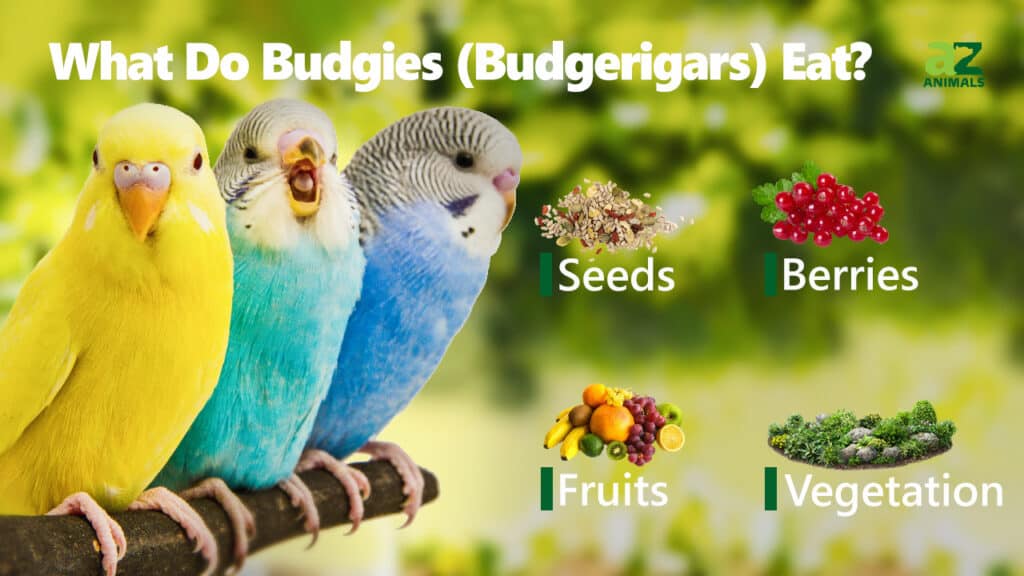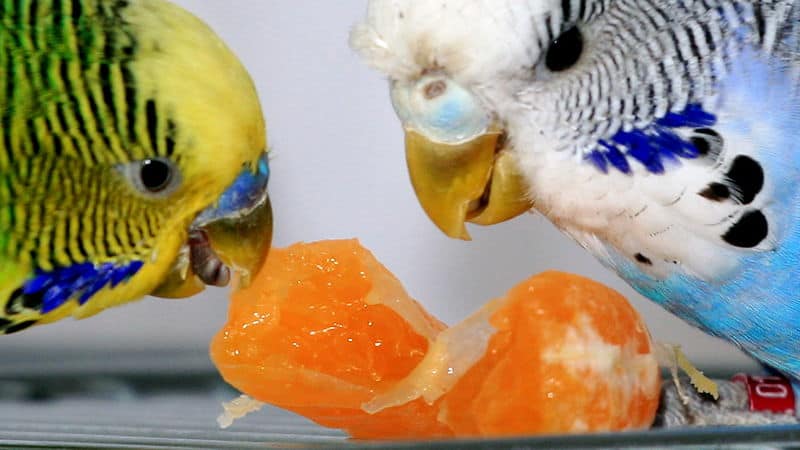Native to Australia, Budgerigars are brightly colored birds in the parrot family, commonly called parakeets. The scientific name for this species is Melopsittacus undulatus. Melopsittacus is of Greek origin and means’ melodious parrot’, while undulatus is Latin for ‘undulated,’ referring to their wing patterns. These nomadic flock birds are highly adaptable and can breed on the go. They’re very social, can mimic the human voice, and have become common as pets worldwide. In fact, they’re the third most common pet after dogs and cats. So, what do budgies eat? Let’s take a look at their diet in their wild habitat and as pets.
What Do Budgies Eat?

Budgies eat a diet consisting of seeds, grains, and nuts from native grasses and herbs. They are granivorous birds with a beak and flexible tongue well-adapted to this diet.
In the wild, budgies are ground feeders that get the bulk of their diet from grains and grasses. Although this is their typical diet in the wild, these birds are adaptable and can exist on a more omnivorous diet. As pets, they are often fed a wider range of foods. We’ll take a look at what to feed your pet budgie below.
Complete List of 6 Foods Budgies Eat
Below is a list of foods budgies eat:
- Seeds
- Grains
- Nuts
- Fruits
- Vegetables
- Worms
Budgies can eat a wide variety of fresh fruits and vegetables. They love tropical fruits and can enjoy bananas, apples, berries, melons, cherries, and citrus fruits. Fruits with stones or pits should have them removed before feeding. For vegetables, try small portions of cucumber, lettuce, beets, tomatoes, and celery.
What to Feed Budgies

Budgies can enjoy a seed-based diet supplemented with fresh fruits and vegetables.
Dietary protein has an important role to play in the nutrition of pet budgies. This is especially true in the production and health of feathers, claws, and beaks. According to a study by the Waltham Centre for pet nutrition, the protein requirements of Budgies in captivity is estimated to be 10 percent of the diet. This could increase significantly during periods of molting.
One option for feeding Budgies is to buy a pellet mix specifically formulated for them. Another route is to feed a grass and grain seed diet supplemented with a selection of fresh fruits and vegetables. Seeds should make up about 40-60% of the diet. You can choose to craft your own mixes, but ready-made seed mixes are widely available. Since seeds have a short shelf-life, testing their freshness is a good idea. Soak some seeds overnight, rinse and drain them. Spread them out on a wet cotton cloth and keep them warm for 24 hours. If less than 50% of the seeds sprout, they should be thrown out. Budgies love to gnaw on cuttlefish bone, and providing it can be an excellent way to ensure they’re getting the calcium they need.
Complete List of Grass and Grain Seeds to Feed Budgies
- Annual meadow grass
- Meadow foxtail
- Orchard grass
- Perennial ryegrass
- Rough bluegrass
- Soft brome
- Velvet grass
- Timothy grass
- Yorkshire grass
- Amaranth
- Barley
- Buckwheat
- Canary seed
- Oats
- Quinoa
- Rye
- Sweetcorn kernels
- Wheat
How Much Do Budgies Eat?
In the wild, budgies forage the forest or savannah floor, getting just the right amount of nutrition by instinct. In captivity, it’s important not to feed budgies too much, as they can become overweight. They should also not be underfed as it can lead to malnourishment and extreme stress. A healthy amount for an adult budgie is roughly 15-16 grams of food and 3-4 grams of treat items like nuts and sunflower seeds. It’s important to pay attention to your budgie’s dish – if it is consistently emptied all the way, then you know you are likely not feeding it too much. It’s okay to err on the generous side as long as your bird gets plenty of exercises.
What Do Baby Budgies Eat?

Baby budgies are fed a mixture of regurgitated seeds and saliva from their mother’s mouth.
©starry sky/Shutterstock.com
Female budgies lay a clutch of 4 to 6 eggs, then spend about 18 days sitting on them before they hatch. They are completely reliant on their parents for food. These baby birds can’t see or raise their heads. They can’t signal that they’re hungry with movement, but the mother budgie will respond to their noises. The mother will feed them a regurgitated mix of seeds and saliva until they are weaned and ready to fly. A mixture of boiled egg, brown rice, millet, crushed budgie pellets, and grated fruit and vegetables can be fed to very young birds or birds that are unwell and need special care.
What Foods to Avoid Feeding Budgies
Budgies shouldn’t be fed fried food, salt, caffeinated drinks, bread, sweets, peanut butter, or cheese. Also, budgies love seeds that are too rich which can be harmful if fed in large amounts. Make sure to limit feeding your budgie seeds and grains with a high fat content like sunflower, flax, hemp, millet, niger, pumpkin, rapeseed, and sesame.
The photo featured at the top of this post is © iStock.com/Werner Baumgarten
Thank you for reading! Have some feedback for us? Contact the AZ Animals editorial team.







